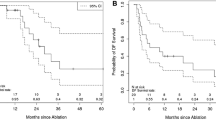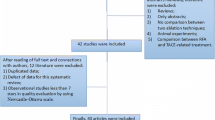Abstract
Objective
To summarize the efficacy and safety of thermal ablation for the treatment of intrahepatic cholangiocarcinoma (ICC).
Methods
MEDLINE, EMBASE, Cochran Library, and Web of Science databases were searched for studies reporting outcomes in patients with ICC treated with thermal ablation. Meta-analyses of cumulative overall survival (OS) and recurrence-free survival (RFS), Kaplan-Meier survival rates according to time to local tumor progression (TTLTP), technical efficacy, and incidence of complications were analyzed. Pooled hazard ratios of common variables were calculated to explore factors associated with OS.
Results
Twenty observational studies comprising 917 patients were reviewed (primary ICC [n = 502]; post-surgical recurrent ICC [n = 355]; information not available [n = 60]). The pooled proportion of technical efficacy was 91.9% (95% CI, 87.3–94.9%). The pooled 1-, 3-, and 5-year OS rates were 82.4% (95% CI, 75.1–88.9%), 42.1% (95% CI, 36.0–48.4%), and 28.5% (95% CI, 21.2–36.2%). Primary tumors showed higher 3-year OS rates than recurrent ones, with borderline significance (p = 0.072). The pooled 1- and 3-year RFS rates were 40.0% (95% CI, 33.6–46.4%) and 19.2% (95% CI, 8.4–32.7%). The pooled 1-, 3-, and 5-year TTLTP rates were 79.3% (95% CI, 65.1–90.9%), 59.5% (95% CI, 49.1–69.4%), and 58.2% (95% CI, 44.9–70.9%). The pooled incidence of major complications was 5.7% (95% CI, 4.1–7.8%). Tumor size (> 3 cm), multiple tumors, and age (> 65 years) were factors associated with shorter OS.
Conclusion
Thermal ablation is a successful alternative with a good safety profile, especially for a single ICC smaller than 3 cm.
Key Points
• The pooled 1-, 3-, and 5-year OS rates following thermal ablation for the treatment of intrahepatic cholangiocarcinoma were 82.4%, 42.1%, and 28.5%.
• The pooled incidence of major complications was 5.7%.
• A tumor size > 3 cm (HR: 2.12, p = 0.006), multiple tumors (HR: 1.67, p = 0.004), and age > 65 years (HR: 1.67, p = 0.006) were factors associated with shorter OS.



Similar content being viewed by others
Abbreviations
- CI:
-
Confidence interval
- DFS:
-
Disease-free survival
- HR:
-
Hazard ratio
- ICC:
-
Intrahepatic cholangiocarcinoma
- IQR:
-
Interquartile range
- LTPFS:
-
Local tumor progression-free survival
- MWA:
-
Microwave ablation
- OR:
-
Odds ratio;
- OS:
-
Overall survival
- RFA:
-
Radiofrequency ablation
- RFS:
-
Recurrence-free survival
- TTLTP:
-
Time to local tumor progression
References
Shaib Y, El-Serag HB (2004) The epidemiology of cholangiocarcinoma. Semin Liver Dis 24:115–125
Blechacz BR, Gores GJ (2008) Cholangiocarcinoma. Clin Liver Dis 12(ix):131–150
Khan SA, Toledano MB, Taylor-Robinson SD (2008) Epidemiology, risk factors, and pathogenesis of cholangiocarcinoma. HPB (Oxford) 10:77–82
Bridgewater J, Galle PR, Khan SA et al (2014) Guidelines for the diagnosis and management of intrahepatic cholangiocarcinoma. J Hepatol 60:1268–1289
Aljiffry M, Walsh MJ, Molinari M (2009) Advances in diagnosis, treatment and palliation of cholangiocarcinoma: 1990-2009. World J Gastroenterol 15:4240–4262
Endo I, Gonen M, Yopp AC et al (2008) Intrahepatic cholangiocarcinoma: rising frequency, improved survival, and determinants of outcome after resection. Ann Surg 248:84–96
DeOliveira ML, Cunningham SC, Cameron JL et al (2007) Cholangiocarcinoma: thirty-one-year experience with 564 patients at a single institution. Ann Surg 245:755–762
Lang H, Sotiropoulos GC, Sgourakis G et al (2009) Operations for intrahepatic cholangiocarcinoma: single-institution experience of 158 patients. J Am Coll Surg 208:218–228
Guglielmi A, Ruzzenente A, Campagnaro T et al (2009) Intrahepatic cholangiocarcinoma: prognostic factors after surgical resection. World J Surg 33:1247–1254
Valle J, Wasan H, Palmer DH et al (2010) Cisplatin plus gemcitabine versus gemcitabine for biliary tract cancer. N Engl J Med 362:1273–1281
Harder J, Riecken B, Kummer O et al (2006) Outpatient chemotherapy with gemcitabine and oxaliplatin in patients with biliary tract cancer. Br J Cancer 95:848–852
Jang JS, Lim HY, Hwang IG et al (2010) Gemcitabine and oxaliplatin in patients with unresectable biliary cancer including gall bladder cancer: a Korean Cancer Study Group phase II trial. Cancer Chemother Pharmacol 65:641–647
Slakey DP (2002) Radiofrequency ablation of recurrent cholangiocarcinoma. Am Surg 68:395–397
Giorgio A, Calisti G, G DES et al (2011) Radiofrequency ablation for intrahepatic cholangiocarcinoma: retrospective analysis of a single centre experience. Anticancer Res 31:4575-4580
Kim JH, Won HJ, Shin YM, Kim KA, Kim PN (2011) Radiofrequency ablation for the treatment of primary intrahepatic cholangiocarcinoma. AJR Am J Roentgenol 196:W205–W209
Yu MA, Liang P, Yu XL et al (2011) Sonography-guided percutaneous microwave ablation of intrahepatic primary cholangiocarcinoma. Eur J Radiol 80:548–552
Fu Y, Yang W, Wu W, Yan K, Xing BC, Chen MH (2012) Radiofrequency ablation in the management of unresectable intrahepatic cholangiocarcinoma. J Vasc Interv Radiol 23:642–649
Haidu M, Dobrozemsky G, Schullian P et al (2012) Stereotactic radiofrequency ablation of unresectable intrahepatic cholangiocarcinomas: a retrospective study. Cardiovasc Intervent Radiol 35:1074–1082
Xu HX, Wang Y, Lu MD, Liu LN (2012) Percutaneous ultrasound-guided thermal ablation for intrahepatic cholangiocarcinoma. Br J Radiol 85:1078–1084
Zhang SJ, Hu P, Wang N et al (2013) Thermal ablation versus repeated hepatic resection for recurrent intrahepatic cholangiocarcinoma. Ann Surg Oncol 20:3596–3602
Amini N, Ejaz A, Spolverato G, Kim Y, Herman JM, Pawlik TM (2014) Temporal trends in liver-directed therapy of patients with intrahepatic cholangiocarcinoma in the United States: a population-based analysis. J Surg Oncol 110:163–170
Takahashi EA, Kinsman KA, Schmit GD et al (2018) Thermal ablation of intrahepatic cholangiocarcinoma: safety, efficacy, and factors affecting local tumor progression. Abdom Radiol (NY) 43:3487–3492
Zhang K, Yu J, Yu X et al (2018) Clinical and survival outcomes of percutaneous microwave ablation for intrahepatic cholangiocarcinoma. Int J Hyperth 34:292–297
Giorgio A, Gatti P, Montesarchio L et al (2019) Intrahepatic cholangiocarcinoma and thermal ablation: long-term results of an Italian retrospective multicenter study. J Clin Transl Hepatol 7:287–292
Ni JY, An C, Zhang TQ, Huang ZM, Jiang XY, Huang JH (2019) Predictive value of the albumin-bilirubin grade on long-term outcomes of CT-guided percutaneous microwave ablation in intrahepatic cholangiocarcinoma. Int J Hyperth 36:328–336
Wu L, Tsilimigras DI, Farooq A et al (2019) Potential survival benefit of radiofrequency ablation for small solitary intrahepatic cholangiocarcinoma in nonsurgically managed patients: a population-based analysis. J Surg Oncol 120:1358–1364
Xu C, Li L, Xu W et al (2019) Ultrasound-guided percutaneous microwave ablation versus surgical resection for recurrent intrahepatic cholangiocarcinoma: intermediate-term results. Int J Hyperth 36:351–358
Brandi G, Rizzo A, Dall'Olio FG et al (2020) Percutaneous radiofrequency ablation in intrahepatic cholangiocarcinoma: a retrospective single-center experience. Int J Hyperth 37:479–485
Diaz-Gonzalez A, Vilana R, Bianchi L et al (2020) Thermal ablation for intrahepatic cholangiocarcinoma in cirrhosis: safety and efficacy in non-surgical patients. J Vasc Interv Radiol 31:710–719
Ge Y, Jeong S, Luo GJ et al (2020) Transarterial chemoembolization versus percutaneous microwave coagulation therapy for recurrent unresectable intrahepatic cholangiocarcinoma: development of a prognostic nomogram. Hepatobiliary Pancreat Dis Int 19:138–146
Chu HH, Kim JH, Shin YM, Won HJ, Kim PN (2021) Percutaneous radiofrequency ablation for recurrent intrahepatic cholangiocarcinoma after curative resection: multivariable analysis of factors predicting survival outcomes. AJR Am J Roentgenol. https://doi.org/10.2214/ajr.20.23461:1-7
Xiang X, Hu D, Jin Z, Liu P, Lin H (2020) Radiofrequency ablation vs. surgical resection for small early-stage primary intrahepatic cholangiocarcinoma. Front Oncol 10:540662
Yang H, Cheng Z, Han Z et al (2021) Assessment of the outcomes of intrahepatic cholangiocarcinoma after ultrasound-guided percutaneous microwave ablation based on albumin-bilirubin grade. Cardiovasc Intervent Radiol 44:261–270
Liberati A, Altman DG, Tetzlaff J et al (2009) The PRISMA statement for reporting systematic reviews and meta-analyses of studies that evaluate healthcare interventions: explanation and elaboration. BMJ 339:b2700
Wells G, Shea B, O’Connell D et al (2012) The Newcastle-Ottawa Scale (NOS) for assessing the quality of nonrandomized studies in meta-analyses. University of Ottawa, Ottawa Available via http://www.ohri.ca/programs/clinical_epidemiology/oxford.asp. Accessed 7 Mar 2021
Han JK, Choi BI, Kim AY et al (2002) Cholangiocarcinoma: pictorial essay of CT and cholangiographic findings. Radiographics 22:173–187
Ahmed M, Solbiati L, Brace CL et al (2014) Image-guided tumor ablation: standardization of terminology and reporting criteria--a 10-year update. Radiology 273:241–260
Khalilzadeh O, Baerlocher MO, Shyn PB et al (2017) Proposal of a new adverse event classification by the Society of Interventional Radiology Standards of Practice Committee. J Vasc Interv Radiol 28(e1433):1432–1437
Lee J, Kim KW, Choi SH, Huh J, Park SH (2015) Systematic review and meta-analysis of studies evaluating diagnostic test accuracy: a practical review for clinical researchers-part II. Statistical methods of meta-analysis. Korean J Radiol 16:1188–1196
Sterne JA, Egger M, Smith GD (2001) Systematic reviews in health care: investigating and dealing with publication and other biases in meta-analysis. BMJ 323:101–105
Mavros MN, Economopoulos KP, Alexiou VG, Pawlik TM (2014) Treatment and prognosis for patients with intrahepatic cholangiocarcinoma: systematic review and meta-analysis. JAMA Surg 149:565–574
Lee DH, Lee JM, Lee JY et al (2014) Radiofrequency ablation of hepatocellular carcinoma as first-line treatment: long-term results and prognostic factors in 162 patients with cirrhosis. Radiology 270:900–909
Chen MS, Li JQ, Zheng Y et al (2006) A prospective randomized trial comparing percutaneous local ablative therapy and partial hepatectomy for small hepatocellular carcinoma. Ann Surg 243:321–328
Soulen MC, Sofocleous CT (2021) Achieving curative ablation outcomes: it is all about the imaging. Radiology 298:219–220
Carrafiello G, Laganà D, Cotta E et al (2010) Radiofrequency ablation of intrahepatic cholangiocarcinoma: preliminary experience. Cardiovasc Intervent Radiol 33:835–839
Mulier S, Ni Y, Jamart J, Ruers T, Marchal G, Michel L (2005) Local recurrence after hepatic radiofrequency coagulation: multivariate meta-analysis and review of contributing factors. Ann Surg 242:158–171
Lu DSK, Raman SS, Limanond P et al (2003) Influence of large peritumoral vessels on outcome of radiofrequency ablation of liver tumors. J Vasc Interv Radiol 14:1267–1274
Han K, Kim JH, Yang SG et al (2021) A single-center retrospective analysis of periprocedural variables affecting local tumor progression after radiofrequency ablation of colorectal cancer liver metastases. Radiology 298:212–218
Khan SA, Tavolari S, Brandi G (2019) Cholangiocarcinoma: epidemiology and risk factors. Liver Int 39(Suppl 1):19–31
Funding
The authors state that this work has not received any funding.
Author information
Authors and Affiliations
Corresponding author
Ethics declarations
Guarantor
The scientific guarantor of this publication is Jin Hyoung Kim.
Conflict of interest
The authors of this manuscript declare no relationships with any companies whose products or services may be related to the subject matter of the article.
Statistics and biometry
No complex statistical methods were necessary for this paper.
Informed consent
Written informed consent was not required for this study because this study is a systematic review and meta-analysis.
Ethical approval
Institutional Review Board approval was not required because this study is a systematic review and meta-analysis.
Methodology
• Meta-analysis
• Performed at one institution
Additional information
Publisher’s note
Springer Nature remains neutral with regard to jurisdictional claims in published maps and institutional affiliations.
Supplementary Information
ESM 1
(DOCX 40 kb)
Rights and permissions
About this article
Cite this article
Kim, G.H., Kim, P.H., Kim, J.H. et al. Thermal ablation in the treatment of intrahepatic cholangiocarcinoma: a systematic review and meta-analysis. Eur Radiol 32, 1205–1215 (2022). https://doi.org/10.1007/s00330-021-08216-x
Received:
Revised:
Accepted:
Published:
Issue Date:
DOI: https://doi.org/10.1007/s00330-021-08216-x




